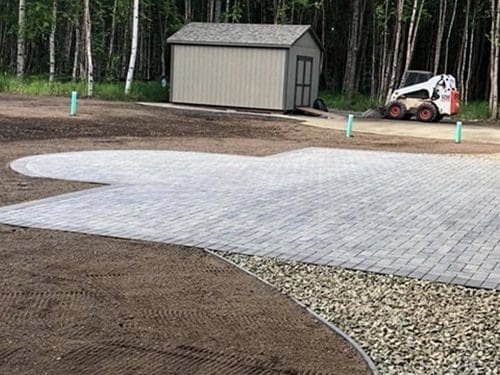Pavers & Patio Construction in Anchorage
Paver walkways and brick patios, not only enhance the aesthetic appeal but also add value to the entry of your home and backyard areas.
Investing in landscaping pavers can have a significant impact on your property value. Pavers, in particular, have become popular among homeowners due to their aesthetic appeal and long-term durability. They increase your home value and add a beautiful touch to any outdoor space, boosting your happiness.

Brick Paver Walkways
Concrete pathway pavers are extremely dense units which possess exceptional strength and durability, superior stability under severe loads, and are minimally affected by the extremes of frost and are easily fixed on rare situations of heaving.
The many shapes, patterns, and colors of concrete pathway pavers allow for design creativity, as well as delineation of pavement areas, such as parking lanes, crosswalks, and intersections. The beauty of pathway pavers adds value and visual appeal to any property. By adding flexibility not possible with rigid pavement, pavers can flow with existing landscaping to deliver beauty to any property. We service residential and commercial properties in Anchorage, Eagle River, and the Mat-Su Valley including Wasilla, Houston, Big Lake, and Palmer.

Brick Paver Patios
Patio pavers offer numerous benefits that make them highly valuable for outdoor spaces. To begin, patio pavers are designed to withstand heavy foot traffic, weather fluctuations and other outdoor elements, ensuring long-lasting performance.
- Pavers are relatively low-maintenance, requiring occasional cleaning and minimal repairs compared to other outdoor surface options.
- If a paver gets damaged, it can be easily replaced without affecting the entire patio.
- They come in a wide range of materials, shapes, colors and patterns, allowing for endless design possibilities and the ability to create a unique outdoor aesthetic.
- Pavers provide a slip-resistant surface, making them safer for walking especially when wet.
What is the difference between brick and concrete pavers?
Brick pavers are molded out of a natural clay blend and fired in a kiln, while concrete pavers are composed of a cement and aggregate mixture that is molded, and then air-dried.
Why choose pavers for your landscape design?
Brick and concrete pavers are both durable, long-lasting options for hardscaping projects, but they have some key differences:
Material
Brick pavers are made from clay and fired in a kiln, while concrete pavers are made from a mixture of cement, sand, aggregate, and pigments. Concrete pavers are extremely durable and suitable for high-traffic areas, but brick pavers may outlast concrete by 10 to 20 years
Appearance
Brick pavers have a classic, elegant look, while concrete pavers can mimic the look of bricks or offer a modern touch.
Installation
Brick pavers are molded, which can lead to size variations, and may require more labor. Concrete pavers are manufactured to precise dimensions and are easier to install.
Maintenance
Brick pavers resist staining and require less maintenance than concrete pavers, which need cleaning with a cleaning solution every few months.
Durability
Concrete pavers are extremely durable and suitable for high-traffic areas, but brick pavers may outlast concrete by 10 to 20 years.
PROJECT GALLERY









































